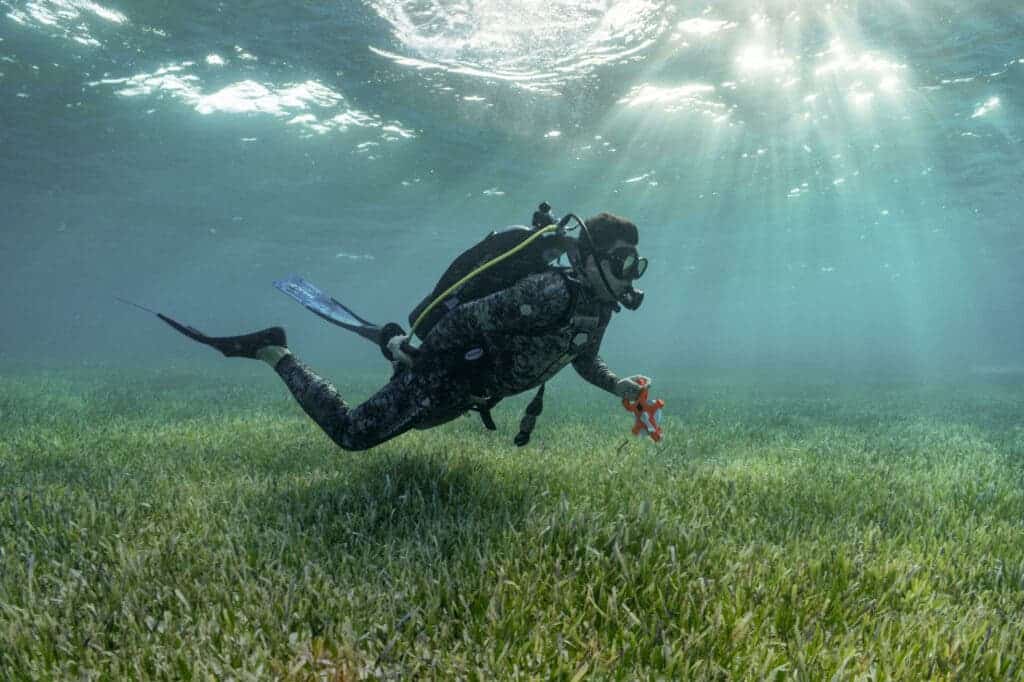Seagrass meadows are one of the most underrated carbon-sequestering ecosystems in the world. They have the potential to store 83 million metric tons of blue carbon (carbon stored in ocean-based ecosystems) every year. Plus, the cost of carbon-capture services that seagrass meadows offer currently stands at $2.3 trillion. Therefore, it becomes very important to map and protect these marine habitats.
But because they’re underwater and often hard to access, studying seagrass hotspots isn’t so easy. Which is why researchers recruited an unlikely ally for the mission: sharks.
A team of researchers from Beneath The Waves (BTW), a non-profit that focuses on ocean conservation practices, performed seagrass mapping of the Bahamas island region using special instrument-equipped tiger sharks. Based on their findings, the researchers claim that the Bahamas banks are actually home to the largest seagrass ecosystem in the world and play a major role in mitigating climate change.

While highlighting the significance of seagrass beds in The Bahamas, one of the authors and the Blue Carbon program manager at BTW, Wells Howe told ZME Science:
“Seagrass meadows protect livelihoods, provide food, enhance the health of our oceans and protect shorelines around the world. They serve as key nursery grounds for a host of marine species, many of which are threatened or protected in The Bahamas – such as the Nassau Grouper, Queen conch, manatees, and sea turtles.”
Tiger sharks led us to a jackpot
The researchers suggest that with over 83% of the global carbon cycle circulated through the ocean, seagrass meadows sequester carbon 35 times faster as compared to tropical rainforests. They can also trap up to 15 times more carbon than tropical rainforests per hectare. Therefore, seagrass meadows serve as one of the best natural solutions and the largest opportunities to fight anthropogenic climate change.
Prior to this discovery, it was also believed that The Bahamas have seagrass meadows but the extent or scale up to which these meadows were spread was largely undocumented.
During their study, the researchers came to know that tiger sharks spent around 70% of their time swimming over seagrass meadows and they were able to scout deeper areas than those surveyed by humans, with tiger sharks extending well below the depth limit of seagrass (maximum depth reached by tiger sharks 608 m).
Moreover, the sharks could go further into the interior of the vast Great Bahama Bank, areas not logistically possible for human access. In order to utilize these uncanny strengths of the sharks, the authors came up with an innovative way to map The Bahamas. They tagged and tracked 15 tiger sharks in the Bahamas with biologging camera packages and satellite tags, including the first-ever deployment of a 360-degree camera borne by a marine animal.

Satellite-tagged tiger sharks traversed over 4,000 km on both regions of The Bahama Banks. The data and images received from the instrument-equipped sharks were then studied along with information collected from more than 2,500 surveys that were performed by human divers. This research led to the discovery of the largest seagrass meadow on our planet, located in the Bahamas.
When asked about the size of the meadow that is discovered using tiger sharks, Wells Howe explained:
“The Bahamas Seagrass Meadow is a continuous ecosystem spanning 92,000 km2 across the Bahama Banks. Our published results represent a 41% increase in the projected global estimate of seagrass. In the scientific community, we still have a poor understanding of global seagrass habitats, and this new discovery shows that it is highly likely that there are still many ‘hotspots’ left to be discovered.”
How much blue carbon is stored by these meadows?
The authors estimate that the Bahamas Banks seagrass meadow stores about 0.46 to 0.63 Pg (Peta gram, one Peta gram is equal to a billion tons) of organic carbon. With reference to the global seagrass carbon stock estimates, these results indicate that seagrass in the Bahamas may contain 19.2% to 26.3% of all the carbon sequestered in seagrass meadows on earth. These findings highlight the significant role the Bahamas seagrass play in reducing the impact of climate change on our planet.

This discovery also sheds light on how marine animals like tiger sharks can help us study the environment. In order to conduct more such surveys in the future and keep an eye on the health of the seagrass meadows, it is important that the sharks stay healthy and protected. Without these animals, it would be impractical and almost impossible to perform seagrass mapping of regions like The Bahamas.
The researchers at BTW highlight that the Prime Minister of The Bahamas, Philip Brave Davis, has emerged as a key leader in the region’s climate change advocacy. In June 2022, the Government of The Bahamas passed new legislation on climate change, including a measure to designate and protect new marine areas of seagrass meadow. The prime minister has also appreciated the efforts of BTW, in one of his statements, he said,
“The innovative work done by Beneath the Waves, in partnership with Bahamians, to map our country’s vast seagrass meadows, represents extraordinary scientific progress, and will make a very significant contribution to our national development and security.” He further added, “The Bahamas maybe at the top of rankings on climate vulnerability, but we now have evidence that we top the list of the world’s blue carbon hotspots, too–which means our seagrasses can play a critical role in generating the resources we need to transition to renewable energy and to adapt and become more resilient to the changing climate.”
The study is published in the journal Nature Communications.


